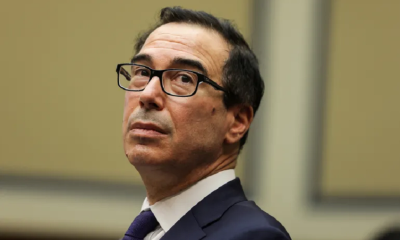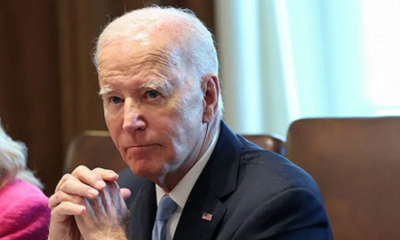Foreign News
House votes to impeach homeland security secretary Alejandro Mayorkas

The House of Representatives has narrowly voted to impeach Homeland Security Secretary Alejandro Mayorkas, making him the first cabinet member to face impeachment in nearly 150 years.
Many Republicans blame Mayorkas for an unprecedented influx of migrants at the US-Mexico border.
The Republican-led chamber voted 214 to 213 for the measure, after the first attempt failed last week. The issue now heads to the Democratic-led Senate, where it is likely to fail.
President Joe Biden on Tuesday called the vote a “blatant act of unconstitutional partisanship” and a “political stunt”.
Opponents of Mr Mayorkas accused him of not living up to his oath to “well and faithfully discharge the duties” of his office by failing to do more to secure the border.
The vote was largely divided along party lines, with 210 Democrats voting against the impeachment, along with three Republican representatives: Tom McClintock of California, Ken Buck of Colorado and Mike Gallagher of Wisconsin.
The three defectors also voted against the first attempt to impeach Mr Mayorkas, saying that impeaching someone who had not committed a serious crime would weaken the constitutional penalty and do little to address the crisis at the border.
More than 6.3 million migrants have entered the US illegally since 2021, making immigration a divisive and politically contentious issue ahead of the November election. The issue is a major focus of Donald Trump’s campaign to oust Mr Biden from office.
In a statement released shortly after the vote, Mr Biden defended Mr Mayorkas, calling him “an honourable public servant”. “He has upheld the rule of law faithfully and has demonstrated a deep commitment to the values that make our nation great,” the president said.
A spokesperson for the Department of Homeland Security, Mia Ehrenberg, accused Republicans of spending their time “trampling on the constitution” instead of “working to solve the serious challenges at our border”.
Republican Speaker of the House Mike Johnson said Mr Mayorkas “deserves to be impeached”. Over the course of two hearings in January, Republicans charged Mr Mayorkas with failing to enforce immigration policies and lying about the border’s security.
Democrat Al Green, of Texas, appeared unexpectedly after being wheeled into the chamber wearing hospital scrubs to vote against the impeachment. He had been in an emergency room having surgery.
House Majority Leader Steve Scalise also cast his vote after missing the last vote because of cancer treatment. His return gave Republicans the margin needed to secure the vote.
Impeachment – a process outlined in the US Constitution – marks the first step in removing a federal official for high crimes or misdemeanours. It requires a simple majority in the House, then a trial in the Senate. A two-thirds majority is needed for that to succeed.
The impeachment effort is unlikely to pass as the Senate is narrowly controlled by the Democrats.
The House is due to present the impeachment articles to the Senate on 26 February.
The last cabinet secretary to be impeached was Secretary of War William Belknap in 1876, although he resigned shortly ahead of the vote.
A January poll conducted by CBS – the BBC’s US partner – suggests that nearly half of Americans view the situation at the border as a crisis, with 63% wanting “tougher” policies at the border.
The US Customs and Border Protection agency on Tuesday said border crossings were down 50% in January, attributing the dramatic drop to “seasonal trends, as well as enhanced enforcement efforts”.

Foreign News
Nasa ‘Earthrise’ astronaut dies at 90 in plane crash

Apollo 8 astronaut Bill Anders, who snapped one of the most famous photographs taken in outer space, has died at the age of 90.
Officials say a small plane he was flying crashed into the water north of Seattle, Washington.
Anders’ son Greg confirmed that his father was flying the small plane, and that his body was recovered on Friday afternoon. “The family is devastated. He was a great pilot. He will be missed,” a statement from the family reads.
Anders – who was a lunar module pilot on the Apollo 8 mission – took the iconic Earthrise photograph, one of the most memorable and inspirational images of Earth from space.
Taken on Christmas Eve during the 1968 mission, the first crewed space flight to leave Earth and reach the Moon, the picture shows the planet rising above the horizon from the barren lunar surface.
Anders later described it as his most significant contribution to the space programme.

The image is widely credited with motivating the global environmental movement and leading to the creation of Earth Day, an annual event to promote activism and awareness of caring for the planet.
Speaking of the moment, Anders said: “We came all this way to explore the Moon, and the most important thing that we discovered was the Earth.”
Officials said on Friday that Anders crashed his plane around 11:40PDT (1940BST).
The US National Transportation Safety Board (NTSB) said the 90-year-old was flying a Beechcraft A A 45 – also known as a T-34. The agency said that the plane crashed about 80ft (25m) from the coast of Jones Island.
Anders also served as the backup pilot to the Apollo 11 mission, the name of the effort that led to the first Moon landing on July 24, 1969.
Following Anders’ retirement from the space programme in 1969, the former astronaut largely worked in the aerospace industry for several decades. He also served as US Ambassador to Norway for a year in the 1970s.
But he is best remembered for the Apollo 8 mission and the iconic photograph he took from space.
“In 1968, during Apollo 8, Bill Anders offered to humanity among the deepest of gifts an astronaut can give. He traveled to the threshold of the Moon and helped all of us see something else: ourselves,” Nasa Administrator Bill Nelson said in a statement.
Mark Kelly, a former astronaut who now serves as a US Senator for the state of Arizona, said in a post on X, formerly Twitter, that Anders “inspired me and generations of astronauts and explorers. My thoughts are with his family and friends”.
[BBC]
Foreign News
China’s Chang’e-6 lifts off from far side of Moon with rock samples

A Chinese spacecraft carrying rock and soil samples from the far side of the Moon has lifted off from the lunar surface to start its journey back to Earth, according to state media.
The achievement on Tuesday is a world first and the latest leap for Beijing’s decades-old space programme, which aims to send a crewed mission to the Moon by 2030.
The Xinhua News Agency, citing the China National Space Administration (CNSA), said that the ascender of the Chang’e-6 probe took off at 7:38am local time on Tuesday (23:38 GMT) and entered a preset orbit around the moon.
It described the move as “an unprecedented feat in human lunar exploration history”.
The Chang’e-6 probe was launched last month and its lander touched down on the far side of the Moon on Sunday. It used a drill and robotic arm to dig up soil on and below the Moon’s surface, according to Xinhua.
After successfully gathering its samples, the Chang’e-6 unfurled China’s national flag for the first time on the far side of the Moon, it said.
The agency cited the CNSA as saying that the spacecraft stowed the samples it had gathered in a container inside the ascender of the probe as planned.
[Aljazeera]
Foreign News
China says its spacecraft lands on Moon’s far side

China says its uncrewed craft has successfully landed on the far side of the Moon – an unexplored place almost no-one tries to go.
The Chang’e 6 touched down in the South Pole-Aitken Basin at 06:23 Beijing time on Sunday morning (22:23 GMT Saturday), the China National Space Administration (CNSA) said.
Launched on 3 May, the mission aims to collect precious rock and soil from this region for the first time in history. The probe could extract some of the Moon’s oldest rocks from a huge crater on its South Pole.
The landing was fraught with risks, because it is very difficult to communicate with spacecraft once they reach the far side of the Moon. China is the only country to have achieved the feat before, landing its Chang’e-4 in 2019.
After launching from Wenchang Space Launch Center, the Chang’e 6 spacecraft had been orbiting the Moon waiting to land. The lander component of the mission then separated from the orbiter to touch down on the side of the Moon that faces permanently away from Earth.
During the descent, an autonomous visual obstacle avoidance system was used to automatically detect obstacles, with a visible light camera selecting a comparatively safe landing area based on the brightness and darkness of the lunar surface, the CNSA was quoted as saying by state-run Xinhua news agency.
The lander hovered about 100m (328ft) above the safe landing area, and used a laser 3D scanner before a slow vertical descent. The operation was supported by the Queqiao-2 relay satellite, the CNSA said.
Chinese state media described the successful landing as an “historic moment”. The state broadcaster said “applause erupted at the Beijing Aerospace Flight Control Center” when the Chang’e landing craft touched down on the Moon early on Sunday morning.
The lander should spend up to three days gathering materials from the surface in an operation the CNSA said would involve “many engineering innovations, high risks and great difficulty”. “Everyone is very excited that we might get a look at these rocks no-one has ever seen before,” explains Professor John Pernet-Fisher, who specialises in lunar geology at the University of Manchester.
He has analysed other lunar rock brought back on the American Apollo mission and previous Chinese missions. But he says the chance to analyse rock from a completely different area of the Moon could answer fundamental questions about how planets form.
Most of the rocks collected so far are volcanic, similar to what we might find in Iceland or Hawaii. But the material on the far side would have a different chemistry . “It would help us answer those really big questions, like how are planets formed, why do crusts form, what is the origin of water in the solar system?” the professor says.
The mission aims to collect about 2kg (4.4lb) of material using a drill and mechanical arm, according to the CNSA.
The South Pole–Aitken basin, an impact crater, is one of the largest known in the solar system.
From there, the probe could gather material that came from deep inside the lunar mantle – the inner core of the Moon – Prof Pernet-Fisher says.
The Moon’s South Pole is the next frontier in lunar missions – countries are keen to understand the region because there is a good chance it has ice.

The capsule in the last Chinese moon mission, Chang’e 5, brought back soil and rocks in 2020 (BBC)
Access to water would significantly boost the chances of successfully establishing a human base on the Moon for scientific research.
If the mission succeeds, the craft will return to Earth with the precious samples on board a special return capsule.
The material will be kept in special conditions to try to keep it as pristine as possible.
Scientists in China will be given the first chance to analyse the rocks, and later researchers around the world will be able to apply for the opportunity too.
This is the second time China has launched a mission to collect samples from the Moon.
In 2020 Chang’e 5 brought back 1.7kg of material from an area called Oceanus Procellarum on the Moon’s near side.
China is planning three more uncrewed missions this decade as it looks for water on the Moon and investigates setting up a permanent base there.
Beijing’s broader strategy aims to see a Chinese astronaut walk on the moon by around 2030.
The US also aims to put astronauts back on the moon, with Nasa aiming to launch its Artemis 3 mission in 2026.
(BBC)
























